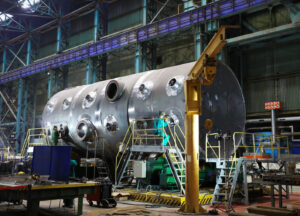by Adam Tooze on 6th July 2020 @adam_tooze
Adam Tooze argues the European Green Deal and young Europeans’ activism are fostering a virtuous circle favouring more rapid decarbonisation. In the 1980s the dawning of global awareness of the climate problem coincided with the politics of the market revolution, also known as neoliberalism. Naomi Klein has described this conjuncture as a tragic coincidence. Environmental policy was steered towards limited, market-based solutions, above all centring on schemes for emissions trading. To turn the giant oil tanker of the modern economy in a new direction we would rely on the price mechanism.
Thirty years on, as the pace of the climate crisis accelerates, the self-confident assumptions of policy discourse framed in the 1980s and 90s have collapsed. Rather than imagining ourselves as captains of a giant ship, as Jörg Haas of the German Greens’ Heinrich Böll Stiftung has argued, our situation today is more like that of a rally driver hurtling towards a corner, desperately trying to point the car in the right direction. We should be pumping the gas, hitting the brakes and pivoting the steering wheel all at once.
If 2008 and its aftermath had not already taught us, after Covid-19 we know for sure that when the status quo is put seriously in question the actual motto of modern government is: ‘whatever it takes’. And, faced with the scale and urgency of the climate crisis, we must demand a no-less-radical approach.
We should be using everything, from targeted investment strategy to conditional government aid and green ‘quantitative easing’. Subsidised feed-in tariffs, penalties for dirty consumption and generous spending on research and development all have their role to play. Nothing should be off the table, including outright prohibitions and nationalisation of key business interests.
Carbon pricing
Since time is not on our side, we need to preserve the maximum freedom of action. We should avoid, as far as possible, getting bogged down in politically damaging debates about the totemic policies of an earlier era—above all carbon pricing. Time is too short to cling to the neoliberal dogma that creating markets and setting prices is the high road to success in all cases. Carbon prices, whether set by emissions trading or carbon taxes, are unlikely to be enough.
Take petrol, which in Europe and Asia has long been the object of eye-watering taxation. As a result, Europeans and Asians drive smaller cars than Americans. But they still drive far too much and their cars are far too big. Prices are not enough. We shall need to use more direct disincentives, regulations and prohibitions, such as mandating the end of internal-combustion engines.
Not only is carbon pricing not sufficient. It also produces collateral damage. The impact of regressive price and tax increases on those at the bottom of the income distribution can be truly painful. That risks provoking a backlash and stiffening political resistance to decarbonisation, which we can ill afford.
In the urgent push for action, we cannot however escape our history. Since the 1990s, carbon pricing has been at the core of European environmental policy. It retains committed elite support, including from influential voices in the German government, which will be directing European Union affairs for the next six months.
If set right, prices do have the attraction of providing a pervasive general incentive to cut back on what needs to be cut back—namely emissions. In this respect, they are a useful complement to more targeted policies.
If a high-enough floor price is set, along with a credible commitment to future increases, this will sway investment decisions and fuel choices. The near-total displacement of coal in the mix of UK electricity generation is a case in point.
Emissions Trading System
In the late 1990s and early 2000s, the EU went to the bother of building the Emissions Trading System. In light of experience, if we had our time over we might not do so again. But the whole point of the climate crisis is that we cannot have our time over: the clock is ticking fast.
Furthermore, the EU-ETS is working. This is surprising, not only because of the scheme’s chequered history but also because, on the face of it, conditions in 2020 could hardly be less propitious.
Thanks to the coronavirus-induced recession, energy demand has collapsed. There would be every reason, therefore, to expect the system to have been swamped by a surplus of emission allowances, whose prices we should expect to fall. But instead, after an initial downward blip, prices for European carbon allowances have recovered to near their pre-crisis level, at around €25 per tonne.
Combined with the collapse of natural-gas prices, we thus find ourselves at the fuel-switching point. At the current price for allowances and given the relative prices of gas and coal, the most efficient power plant burning coal cannot compete with the least efficient gas-fired plant. If sustained, this should spell the end for commercial coal-fired power in Europe. Gas is, at best, a transition fuel but ending coal would be a big win.
According to knowledgeable market participants, emission allowances are trading at such robust prices because market actors believe the EU’s commitment to rapid decarbonisation—as manifested in the European Green Deal—is genuine. This is hugely significant.
‘Minsky moments’
Markets are driven by narratives. Money is made by betting on good news or bad news, prices up or prices down. The crucial thing is to anticipate the direction of travel.
Generally, and for good reason, we assume that speculation driven by private profit will run counter to the intentions of progressive policy. In the modelling of climate ‘Minsky moments’, for instance, we imagine that private investors do not believe governments will stick to decarbonisation policies. It then makes commercial sense to continue to invest in oil, gas and coal, which, in turn, makes it harder to achieve decarbonisation.
It’s a vicious circle. Decarbonisation happens, just not as a smooth and efficient adjustment but in the form of crisis—the Minsky moment in which prices of fossil-fuel assets suddenly reset.
Yet imagine if the logic were reversed. Imagine if speculators persuaded themselves that the smart thing to do was to bet on the realisation of policy, thus hastening that outcome and making it easier for governments to stay the course. Remarkably, that is what seems to be happening in EU carbon markets.
According to insiders, the reason emissions certificates are trading at such high prices is that ‘the market now thinks that even the maximum level of fuel switching will no longer cut CO2 emissions enough for the EU’s longer-term targets to be met and that prices will therefore have to go higher to incentivise reductions in the other sectors covered by the EU-ETS. Indeed, with the EU set to raise its 2030 emissions-reduction target by the end of this year to either 50 per cent or 55 per cent versus 1990 (compared with the current 40 per cent target), and with the scope of the scheme to be expanded over the next few years to include shipping, buildings and transport, there are good reasons to be bullish about further market tightening.’
Investors are not staking their fortunes on a failure of political will. They are betting that faced with the inadequacy of current targets, politicians will double down and raise the ambition of decarbonisation. If politicians follow through on this logic, then emission allowances will become more valuable. Anyone buying them now will have a chance to sell them later at a profit. That anticipation is driving the price of allowances up—and putting coal plants out of business more quickly.
Impressive mobilisation
The analyst community—or at least its environmental, social and governance wing—has become convinced of the seriousness of the climate crisis. And, regardless of personal opinions, they are convinced the current generation of European leaders are committed to the cause. Backing up that political commitment is the force of public opinion and, in particular, the impressive mobilisation of young people which changed the conversation in Europe in 2018-19. Politicians who backslide on the Green Deal can expect to be punished at the polls.
The result is a virtuous circle. It is, in fact, the fantasy of good liberal governance, in which public and private action reinforce each other. That should be reason enough to be sceptical. But, given the urgency of the crisis, we cannot afford to look a gift horse in the mouth. If, for once, investors are betting that the political commitment to decarbonisation is genuine, there are significant and potentially long-term benefits in vindicating that belief, thus reinforcing confidence and building credibility.
It is a sign of the seriousness of our situation that betting on the climate crisis is no longer a matter for long-term speculation. Those holding the emission allowances expect to make money, not perhaps this year but in the foreseeable future. If markets are to play any part in decarbonisation, that expectation must be fulfilled. It is therefore crucial to ensure a Covid-19 recession does not bring on a sudden devaluation of allowances. This happened before—in 2005 and between 2009 and 2013—with discouraging effect.
In the wake of the last price collapse, in 2017 the EU considerably tightened the ETS and introduced the Market Stability Reserve. This mechanism, which came into effect in 2019, was a classic exercise in smokescreen politics. Though the professed goal of the MSR is to stabilise prices by mechanically withdrawing allowances from glutted markets, its true purpose is clearly to support a high and rising price for carbon over the long run. Crucially, the 2017 agreement included a provision to begin cancelling surplus allowances accumulated by the MSR from 2023.
Welcome signal
It is that prospect to which markets are responding, gambling on the seriousness of political commitments. France and Germany sent a welcome signal in their joint initiative of May 18th for European recovery, in which they expressed their support for a floor price for carbon. When the MSR is reviewed in 2021 it could be updated to target explicitly a minimum price. Even more important, as a signal to voters and investors, would be a commitment to raise the ambition of decarbonisation well beyond the current target of 40 per cent by 2030 and to extend the drive to shipping, buildings and transport.
We know from bitter experience that the market-based ETS is not the universal, apolitical device for energy transformation it was once touted to be. It is a weak mechanism whose effectiveness depends on the political will to create scarcity and thus the conditions for meaningful carbon prices. Too often expectations have been disappointed and credibility has been undermined.
Currently, however, market participants are betting that the political will exists to push for deep decarbonisation. That is what a majority of Europeans—particularly young Europeans—want. With the right political leadership, there is an opportunity to turn the ETS from a neoliberal white elephant into an effective instrument of climate policy.
It is an opportunity Europe cannot afford to miss. The more loudly Europeans demand it, the better.
This article is a joint publication by Social Europe and IPS-Journal




